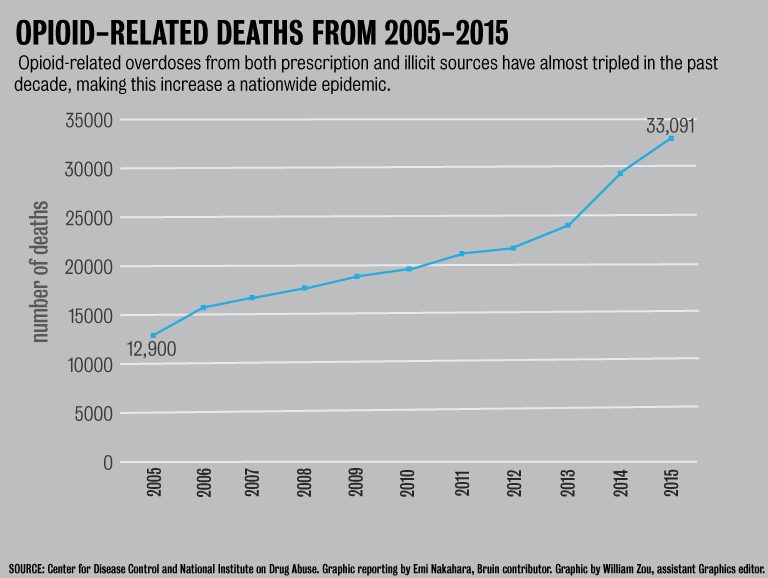UCLA community looks into research, education to tackle opioid addiction

(William Zou/Assistant Graphics editor)
By Emi Nakahara
Jan. 10, 2017 12:34 a.m.
Opioid drug overdoses now claim almost as many lives each year as car accidents in the U.S.
In the last 10 years, opioid-related deaths have nearly tripled and opioid addiction is now regarded as a nationwide epidemic by the Center for Disease Control. In response to the growing epidemic, UCLA students and researchers have been seeking to better understand opioid addiction and find solutions to the problem.
Opioids are typically used in medicine as effective chronic pain relievers, such as oxycodone and morphine. Some opioids, such as heroin, are Schedule I drugs, which means they have no accepted medical use in treatment in the United States, according to the Controlled Substance Act. Both prescription and illicit opioids have contributed to the increased deaths.
Nearly 16 percent of young adults have used pain prescriptions not prescribed to them, according to a survey by the Q Market Research of Minnesota. College athletes reported an even higher percentage of using nonprescribed pain pills than students overall. College students often access opioids from a parent’s or friend’s medicine cabinet.
The Walwyn Laboratory at the Semel Institute for Neuroscience and Human Behavior at UCLA investigates how opioids can alter brain connectivity and the functions of opioid receptors. Another research group at the Semel Institute, the Center for Study of Opioid Receptors and Drugs of Abuse focuses on researching the specific mechanisms of opioids that distinguish it from other drugs.
Wendy Walwyn, an adjunct professor of psychiatry and biobehavioral sciences who leads the Walwyn Laboratory, said opioids are particularly addictive because people use them to eliminate pain rather than solely associating the drug with euphoria. Therefore, opioid withdrawal symptoms are extremely difficult to overcome, she said.
“They’re very different from other drugs,” Walwyn said. “We’re working on this negative reinforcement, and where it’s exactly coming from.”
Christopher Evans, a psychiatry and behavioral sciences professor and director of the CSORDA, said opioids are also very addictive because people become more tolerant of the drugs and need larger doses to relieve pain.
“Withdrawal inhibits their natural reward system, so they don’t feel good about anything,” Evans said. “They’re not seeking highs, but trying to eliminate the lows.”
Walwyn said that some people who are prescribed opioids by a doctor become tolerant to the amount they are given. Often, such patients are addicted by that point, and turn to drugs like heroin, which is cheaper and more potent.
She said people who search for heroin are at an even higher risk of death because heroin sold on streets can be laced with synthetic opioids strong enough to stop people’s breathing.
“People don’t realize what they’ve got in their hands when they have a packet of heroin,” Walwyn said. “They take it and it feels nice, and then find that they can’t breathe, and it’s too late.”
Some students have also become aware of the increased deaths caused by opioids through increased news coverage or personal connections to people who are addicted.
Marissa Ericson, president of Bruins for Recovery and a third-year psychology student, said one of her family members was prescribed the opioid Opana when they were 12 years old for a heart condition.
Bruins for Recovery, a student-run organization, supports students recovering from any kind of substance abuse and advocates for further education about addiction in college campuses.
Ericson said after taking Opana, her family member experienced severe mood swings and self-harmed as a result, and was quickly taken off the medication. The doctor who had prescribed Opana was arrested several years later for prescribing opioids to young people excessively, she said.
Ericson said some of her friends in Orange County who used alcohol and marijuana in middle school began to use heroin in high school.
Last year, fatal opioid overdoses reached a 10-year high in Orange County alone, according to coroner data.
“A lot of young people in high school and college who are addicted to substances think they can’t have fun without it,” Ericson said. “And the substances become normalized.”
Both Walwyn and Evans said there is no easy method to cure opioid addiction. However, there are ways to treat symptoms of opioids when they are life-threatening.
For instance, if someone is overdosing on opioids, the Narcan nasal spray can save the person’s life by reversing the effects of the drug.
Walwyn said she thinks education, less prescription of opioids and more research are key to reduce the large percentage of opioid addiction. She added that using effective treatments can make it easier for addicts to stop using the drugs. For example, fish oil has been found to help alleviate the anxiety from opioid withdrawal and chronic pain.
Ericson said that through Bruins for Recovery, she hopes to expand drug education for students, instead of stressing abstinence from substances. She wants to reduce stigma and emphasize that anyone, including college students, is susceptible to abusing substances.
“When we think of (a) drug addict, we think of a homeless guy under a bridge, but addiction doesn’t discriminate,” Ericson said. “I want to … encourage students to be honest about their addiction problems.”

